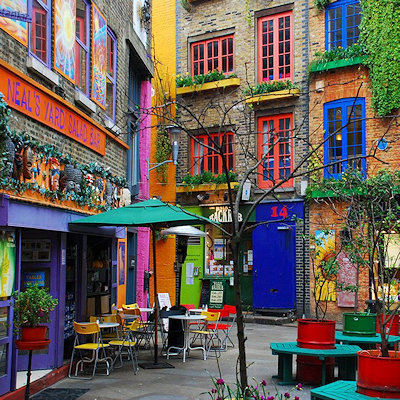
Like us on Facebook
PLACE NAMES


 
|
|
Covent Garden
|

| |
Covent Garden is a district in London on the eastern fringes of the West End, between St Martin's Lane and Drury Lane. It is associated with the former fruit-and-vegetable market in the central square, now a popular shopping and tourist site, and with the Royal Opera House, which is also known as "Covent Garden". The district is divided by the main thoroughfare of Long Acre, north of which is given over to independent shops centred on Neal's Yard and Seven Dials, while the south contains the central square with its street performers and most of the elegant buildings, theatres and entertainment facilities, including the London Transport Museum and the Theatre Royal, Drury Lane.
The area was briefly settled in the 7th century when it became the heart of the Anglo-Saxon trading town of Lundenwic, abandoned at the end of the 9th century. By 1200 part of it had been walled off by Westminster Abbey for use as arable land and orchards. Referred to as "the garden of the Abbey and Convent", and later "the Covent Garden", it was seized by Henry VIII and granted to the Earls of Bedford in 1552. The 4th Earl commissioned Inigo Jones to build some fine houses to attract wealthy tenants. Jones designed the Italianate arcaded square along with the church of St Paul's. The design of the square was new to London and had a significant influence on modern town planning, acting as the prototype for new estates as London grew.
By 1654 a small open-air fruit-and-vegetable market had developed on the south side of the fashionable square. Gradually, both the market and the surrounding area fell into disrepute, as taverns, theatres, coffee-houses and brothels opened up. By the 18th century it had become a well-known red-light district. An Act of Parliament was drawn up to control the area, and Charles Fowler's neo-classical building was erected in 1830 to cover and help organise the market. The market grew and further buildings were added: the Floral Hall, Charter Market, and in 1904 the Jubilee Market. By the end of the 1960s traffic congestion was causing problems, and in 1974 the market relocated to the New Covent Garden Market about three miles (5 km) south-west at Nine Elms. The central building re-opened as a shopping centre in 1980, and is now a tourist location containing cafes, pubs, small shops, and a craft market called the Apple Market, along with another market held in the Jubilee Hall.
With the postcode WC2, Covent Garden falls within the London boroughs of Westminster and Camden, and the parliamentary constituencies of Cities of London and Westminster and Holborn and St Pancras. The area has been served by the Piccadilly line at Covent Garden tube station since 1907; the journey from Leicester Square, at 300 yards, is the shortest in London.
Covent Garden, and especially the market, have appeared in a number of works. In 1867, Johannn Strauss II from Austria composed "Erinnerung an Covent Garden" (Memory of Covent Garden, op. 329). Eliza Doolittle, the central character in George Bernard Shaw's play, Pygmalion, and the musical adaptation by Alan Jay Lerner, My Fair Lady, is a Covent Garden flower seller. Alfred Hitchcock's 1972 film Frenzy about a Covent Garden fruit vendor who becomes a serial sex killer, was set in the market where his father had been a wholesale greengrocer. The daily activity of the market was the topic of a 1957 Free Cinema documentary by Lindsay Anderson, Every Day Except Christmas, which won the Grand Prix at the Venice Festival of Shorts and Documentaries.
|
 Feel free to Email me any additions or corrections Feel free to Email me any additions or corrections
LINKS AVAILABLE TO YOUR SITE
| |





